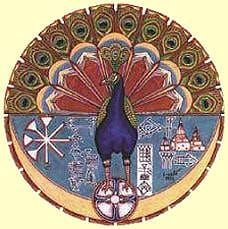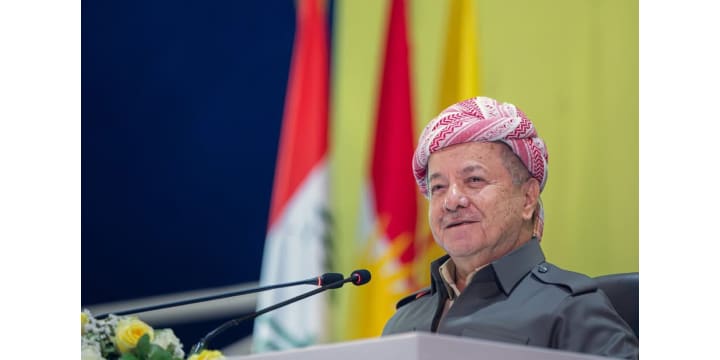
The Holy Yazidi Religious Symbols
The illuminated Lalish Temple: The holiest place among the Yazidis where Yazidis and an important site of pilgrimage. It is one of the ancient archaeological sites in the Kurdistan Region of Iraq. The word Lalish means a luminous lamp (source of light) or the safe place. The Yazidis from all over the world visit the temple and become baptized with the water of Kani Spi (the white spring) and participate in the rituals of Jama’s Eid, which lasts for seven days. The rituals of the peak forty days of summer season and peak forty days of winter season events are also taken place in Lalish. Lighting the candles of the New Year’s ‘Red Wednesday’ is celebrated on the first Wednesday of the Eastern New Year, which comes 13 days after the Gregorian calendar. It is evident from the Yazidi religious text that Lalish flourished the earth as mentioned in this religious text, "When Lalish descended from Heaven on Earth, the plants grewand the appearance of earth began to flourish."
Lalish is located in Sheikhan, 11 km to the north of the city of Ain Sifni and 53 km south-east to the city of Dohuk, in the Kurdistan Region of Iraq. It is located in a valley where water and beautiful trees abound. The temple includes all the shrines of the Yazidi saints and righteous people.
The site of wishes, Dargahe Miraza; the accommodation site of Sheikh Adi; the site of the candles of knowledge, Chraiyen Zanine; the Zimzim Water Spring; olive oil storage in pottery flasks used for lightening, Hasan-Dana; the guests house, Kani Ezi, which is one of the very ancient archaeological sites in Lalish; gathering site of the forty righteous people- the cave of forty men, Chel Meran; the cave of Sheikh Hassan; the cave of Sharfaddin and other sacred sites.
The most important rituals that take place in the sacred site of Lalish are:
- Baptism from the water of Kani Spi
- Qantaar, known as the religious dance Sama, performed especially for acquaintances and interactions among attendants as part of the events of Jama Easter
- Pari Swarkern, an event of Jama Easter where people cover the graves of the saints and righteous people with baptized cloth from the water of Kani Spi
- Qapagh, the upholding and sanctification of sacrificial ceremonies offering the sacrifice such as cow calf
- Bare Shubake, an event inside the accommodation site of Sheikh Adi.
- Tawus Juwankirin, the embellishing of the peacock and the preparations for the peacock tour
- Barat Making, the process of mixing holy dust of Lalish and the water of Kani Spi. Creating small dried pieces to be distributed over the pilgrims and visitors
- Producing olive oil
As a result of the numerous invasions and genocide campaigns that the Yazidis have faced and the fall of Lalish under the control of enemies, the temple has faced a lot of distortion and destruction to the original pattern. The Kurdistan Regional Government has previously allocated a budget to restore the authenticity and the ancient archaeological features to the temple.
Yazidism, religious philosophy:
The Sun: It is considered the greatest of creation. Yazidis turn towards the sun during prayer, and this confirms the close relationship between Mithraism and the Yazidism. The Sun is known to the Yazidis as the source of good and life.
The majority of Yazidi religious decree and rituals are related to or linked to the Sun according to the belief that the Sun is the light and symbol of the Creator. That is why we find that Yazidism gives great attention and reverence to the Sun, because there is no life without the light and the heat of the Sun. Even the calendar and the Yazidi dates are linked to the Sun.
The Yazidi Spiritual Council: The highest religious body among the Yazidis that consists of five members of religious scholars and they include the Emir, Baba Sheikh, Chief Qawwal, Sheikh Al-Wazir and Peshmame Margahe. The council supervises all religious matters of the Yazidis. The main office of the council is located in the Holy Lalish.
The Emir of the Yazidis is the head of this council. Baba Sheikh represents the highest spiritual level and supervises a group of scholars and clerics. They include Baba Chawish, Babe Gavan, Peshmam, Kochak and Ekhtiyare Margahe, and Mujewer- Sardariye Parastgeha Lalish; who manages the daily works of Lalish. These scholars and clerics participate in all religious ceremonies and rituals, especially those performed in the Lalish Temple.
The Holy Books: The root of any idea or belief go back to a specific place and time and that any belief or idea during its emergence must depend on religious texts and principles that are published in their holy books. Unfortunately, however, the private books of the Yazidis were lost or burned during invasions and despite that some writers and researchers present from time to time some books and claim that they are from the sacred books of the Yazidis. Yazidis do not recognize these books and exclude them from their books, but some of these pages could help us identify the language of those writings which seem to be written with the original Kurdish letters.
The sacred religious texts constitute the main source of the Yazidis' principles and beliefs and it is considered an inherent legacy of written and oral Kurdish literature. The book “Muzhdaha-Rouzh” which means the gift of the Sun was burned and destroyed by the enemies and invaders. The majority of these religious instructions were returned in the book “Mus-hafa Rash” which is the holy book that brought back oral religious texts from people who memorized them. These texts and beliefs were successively transferred from one generation to another and it contains the details about the creation of the universe and the angels, the history of the emergence of the Yazidis and their faith, Sharia law explaining what is permissible and what is forbidden, fasting, prayers, pilgrimages, zakat, the fate of the soul after death, an explanation of the their peacock tours to collect alms and vows and also about the most important rituals of holidays and occasions. During the period of Sheikh Hasan, he wrote a book of interpretation of religious principles and rituals in a book called ‘Al-Jilwa.’
Peacocks (Sanjak) tour known as Tawos Gerran: The peacock is one of the sacred religious symbols of Yazidism and each Yazidi has its own Sanjak to tour their respective areas to spread the teachings of the religion and establish its ceremonies in the area they visit. There is a special system arranged for the Sanjaks, which began more actively in era of Sheikh Adi to spread the teachings of the religion. He used to visit twice a year to Yazidi areas during special occasions accompanied with a group of qawwals (presenters) who educate people on religion and give advice to them on how to solve their social differences, as well as analyze and interpret religious instructions and religious texts for people.
It is noteworthy to say that the Yazidis have shrines and religious sites scattered in all areas of the Yazidi presence.
Shamo Qasim
Head of the Cultural Department at Lalish Center

